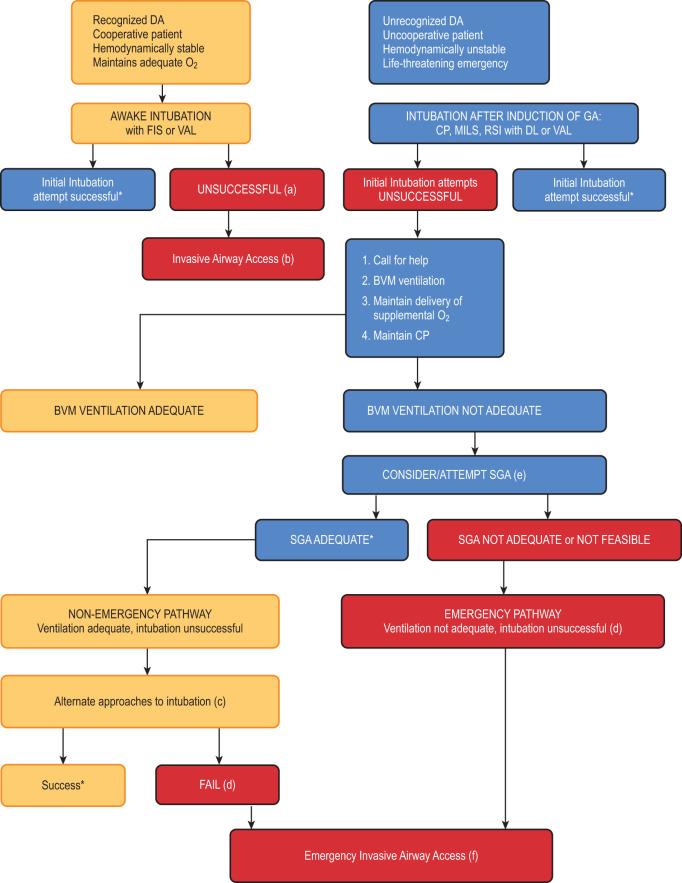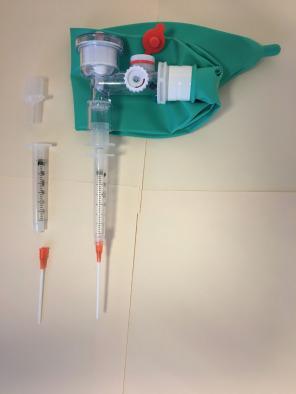Physical Address
304 North Cardinal St.
Dorchester Center, MA 02124
Intraoperative anesthesia emergencies are common. Many emergencies can be prevented by effective preoperative evaluation. Successful treatment requires adequate preparation of equipment and drugs. Routine simulation of emergency scenarios will increase the likelihood that the intervention will be timely and successful. The purpose of this chapter is to describe the prevention and treatment of these emergencies if they occur.
Many emergencies can be prevented by effective pre-operative evaluation. Information gained during the pre-operative evaluation informs the anesthesiologist of anatomical, pharmacological, and medical abnormalities/conditions that may result in intraoperative complications. The knowledge gained allows the anesthesiologist to have available sufficient oxygen, drugs, and equipment to treat problems should they occur, to prevent potentially injurious or deadly delays in treatment of emergencies, and to have available adequate quantities of blood and blood products and the means of rapidly delivering them if needed (sufficient IV access, rapid infuser). Above all, we recommend that scenarios be created and that interventions be practiced on a routine basis. Simulation of these events in a realistic way will increase the likelihood of success.
Appropriate intraoperative monitoring may give an early warning of potential problems and includes non-invasive arterial blood pressure, heart rate, ECG, respiratory rate, Sa o 2 , and CO 2et . If extensive blood loss is expected (burns, large grafts, vascular tumors), intravascular arterial blood pressure and central venous pressure (CVP) monitoring may be useful.
Airway emergencies occur frequently, especially during head and neck surgery, and are more common in the presence of airway abnormalities (e.g., small mouth or chin, inability to move the neck, Treacher Collins syndrome, or extensive burn scarring). Inflammation and edema of the face and neck (e.g., burns, infections) are indications that intubating the trachea may be difficult. This knowledge allows the anesthesiologist to determine the best way to provide an airway.
The ability to effectively ventilate the lungs of the patient with a bag-and-mask during an emergency is paramount, but it may be difficult to do so if the patient has facial anomalies such as hemifacial syndrome, Pierre Robin syndrome, facial clefts, cicatrices of the nose/mouth, and tumors of the face and mouth (e.g., angiomas). This is because it may be difficult or impossible to obtain a tight seal between the mask and face. If the seal is poor, gas will leak from between the mask and face during positive pressure ventilation, reducing the effectiveness of ventilation. Using a standard or round mask with large air-filled cuffs, placing sponges between the mask's cuff and cheeks to block the gas leak, and/or gathering the cheek under the mask to fill the space are techniques that may prevent or reduce the leak. It may take two people to effectively ventilate such patients: one to apply the mask and the other to ventilate the lungs. When using a mask with wide cuffs, care must be taken not to occlude the nares by allowing the mask to slide down and close the nares. If trauma, burns, or edema occludes the nares, closing the mouth during attempts to ventilate the lungs may result in total airway obstruction. Insertion of a nasal or oral airway usually overcomes this problem. However, congenital lesions or burns affecting the mouth and/or nose may make it impossible to insert these devices. Sometimes, if the mouth can be opened, the lower end of the mask can be inserted inside the lower teeth while doing a jaw thrust to allow ventilation of the lungs. Special care is required when inserting nasal airways in children who have not had adenoidectomy because their adenoids are often chronically infected and fragile. Inserting a nasal airway may dislodge a piece of infected adenoid and cause severe hemorrhage, worsening the airway problems. Laryngeal mask airways (LMAs) are important aids in obtaining an emergency airway (if the mouth opens enough to permit its placement). However, LMAs increase dead-space ventilation and raise the Pa co 2 . They also may cause pharyngeal necrosis if left inflated for 4 hours or more.
Tracheal intubation of most patients is accomplished using a standard laryngoscope and an appropriate-size laryngoscope blade and a cuffed endotracheal (ET) tube. For maximum stability and reduced dental injury, approximately 80% of the blade should be within the mouth at the time of intubation. Fiber-optic laryngoscopes (e.g., GlideScope™) often allow tracheal intubation during an emergency if the anesthesiologist is facile with these devices. The glottis of children <5 years of age is located more cephalad, making it more difficult to visualize this structure. The laryngoscope blade should not be allowed to press on the gums of babies because this may permanently damage their tooth buds.
The anesthesiologist must quickly determine how to provide an airway when unexpectedly faced with a difficult airway in an anesthetized patient (one option is not to continue with the anesthetic/surgery!). Fig. 1.6.1 is the difficult airway algorithm. Following this algorithm avoids unnecessary delays in obtaining an airway and may prevent injury to the patient. Because a difficult airway may occur at any time, equipment for treatment of a difficult airway must be readily available in every case.

Laryngospasm often results in complete airway obstruction, hypoxemia, and hypercarbia. Laryngospasm can usually be broken by applying sufficient pressure to the angles of the jaws to cause pain while simultaneously applying 20 to 25 cm H 2 O pressure with a bag-and-mask through a tight-fitting face mask (laryngospasm occurs only when the level of anesthesia is light). The pain and airway pressure usually result in progressive opening of the vocal cords, permitting ventilation. If this maneuver does not allow lung ventilation in 15 to 30 seconds, anesthesia can be deepened with propanol and succinylcholine (2 mg/kg), or rocuronium (0.6 mg/kg to 1.0 mg/kg) can be given intravenously while continuing to apply pressure to the jaw and lungs. Unless the situation is life-threatening, avoid administering succinylcholine to children because of the increased risk of cardiac arrest due to hyperkalemia that occurs in some children (usually males) who have undiagnosed myotonia.
If ventilation with a bag-and-mask is not possible after insertion of an oral airway or an LMA, a large-bore IV cannula can be inserted quickly into the trachea through the cricothyroid membrane ( Fig. 1.6.2 ) and connected to a 3.5-mm ET tube tracheal tube connector. This allows oxygen administration, but exhalation may be difficult, especially if the glottic obstruction is complete. When this occurs, the lungs may be overinflated and interfere with pulmonary perfusion or cause a pneumothorax. If the vocal cords are not totally occluded, exhalation will occur through the mouth and not through the tracheal catheter. With this device the ventilation rate in adults and teenagers is 4 to 6 breaths per minute and in young children is less than 10 breaths per minute. While the cannula is being inserted, the surgeons and nurses should be preparing to insert a tracheostomy.

Become a Clinical Tree membership for Full access and enjoy Unlimited articles
If you are a member. Log in here